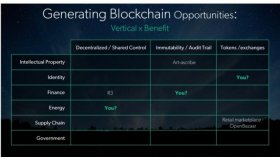
Best blockchain ideas
At BigchainDB, people often approach us with their “next great blockchain idea.” At least 8 times out of 10, that idea could be best implemented by a traditional database. But sometimes, the ideas are genuinely applicable.
Here’s a way to generate applicable ideas more efficiently: combine one of the known blockchain benefits with one of the most applicable verticals.
You can make a grid of it, where each cell in the grid has opportunity:

For example:
I could easily put dozens more companies into these cells; actually, my notes contain that. But that’s not the point here.
The point is for you to generate opportunities for yourself: "Look at any given cell and ask: how do I offer this benefit (column) to this vertical (row)? There’s tons of room in any given cell, since each vertical has so many sub-verticals, like music vs photos for IP."
This tool is not a panacea: it does not cover all possible blockchain business models, opportunities, benefits, or verticals. And, obviously many have written about blockchain and business. Nonetheless, perhaps you can find this tool useful.
The rest of this post quickly reviews specific benefits and the application verticals, and provides links to more detail yet.
Blockchain Benefits (in Columns)
What specific benefits do blockchains bring compared to traditional databases? We found three:
- Decentralized / shared control. It allows enemies to work together for common benefit, like R3 for banks. It enables new public utilities, like Ethereum for decentralized processing. And, interoperability protocols like Interledger and IPLD mean you aren’t stuck to one network. Blockchains are political tools.
- Immutability / audit trail. When you write data to a blockchain, it’s like etching the data into stone. Related transactions over time gives an immutable audit trail. For example, ascribe in art gives immutable attribution and history of owners.
- Assets / exchanges. Assets themselves can live on the data store. This in turn lowers friction to implementing exchanges. This works for traditional exchanges like stocks (e.g. NASDAQ / Chain), or multi-sided platforms like online retail (e.g. OpenBazaar).
This Article describes the benefits further, along with more examples.
Application Verticals (in Rows)
Here are the six application verticals that we see.
- Intellectual property (IP). Art, music, software, logos, more.
- Identity (ID). Personal data, health data, credentials, assurance.
- Finance. Delivery-versus-payment. Remittance, exchanges, more.
- Energy. Implement deregulation.
- Supply chain. Minimize Leaks / fraud, therefore save insurance costs.
- Government. Transparency, registries.









